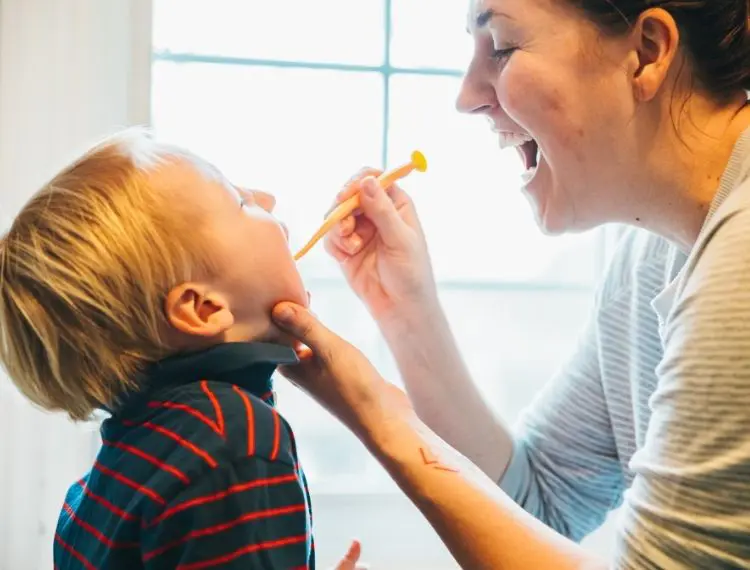
Key messages
- Baby teeth often start to appear around 9 months old.
- Symptoms of teething can include drooling, rubbing the gums, being irritable, mouthing objects and biting.
- First dental visits are recommended when the first teeth appear in the mouth.
- Start using a toothbrush when the first teeth arrive in the mouth.
- You do not need to use toothpaste for your child until they are 18 months old.
- Check your child's teeth at home by lifting their lips and looking at the surface of the teeth. Look out for brown, black or white spots that cannot be removed.
Good oral health care starts in infancy. It is key in the early childhood years to set your child up for good oral health during their life.
The Australian Dental Association recommends children visit the dentist for the first time when the first teeth arrive in their mouth.
Baby teeth development
Baby teeth are the teeth you have during childhood. These teeth begin developing while your baby is still in the womb.
Baby teeth often start to appear around 9 months old. However, this can range 3 to 12 months. However, if your child does not have any teeth by 12 months of age, it is best to have a check-up with a dentist. It is normal for the teeth to arrive in any order. But the middle bottom teeth are often first. All 20 baby teeth usually arrive by age 3.
Sometimes a baby can be born with a tooth. This is called a natal tooth.
See the below guide for when you can expect the different teeth to appear.

Symptoms of teething
Your baby may show symptoms of teething as early as 3 months old. Symptoms can include:
- drooling
- rubbing the gums
- being more irritable than usual
- mouthing objects
- biting.
Some symptoms should not be linked to teething straight away. These can include:
- difficulty sleeping
- a loss of appetite
- coughing
- rashes
- diarrhea
- vomiting
- seizures
- a very high fever.
It is best to see your doctor if your child has these symptoms to rule out other illnesses.
When your child is teething, it can be difficult to make them comfortable. Some suggestions include:
- attention and cuddles
- teething rings or washcloths that are cold but not frozen
- rubbing the back of a cold spoon over their gums
- giving them a dummy.
Be careful if you choose to use the following remedies
When do I start brushing my child’s teeth?
Before you introduce a toothbrush, you may like to use a clean, damp washcloth or muslin cloth to clean your baby's gums.
Start using a toothbrush around 6 months of age or when your baby gets their first tooth. You will need to brush their teeth for them but let them have a turn also.
Children and adults are recommended to brush for 2 minutes. Babies and toddlers only have a few teeth, so you don’t need to brush for this long. But make sure that all surfaces have been reached.
As your baby gets older and has more teeth, you can begin brushing with the aim of reaching 2 minutes. This can be tricky. Make brushing time fun by playing a song or using a phone app that has a timer to help them reach 2 minutes. Phone apps also give positive reinforcement through stickers and awards. Brushing charts and stickers can also provide encouragement.
Babies do not need to use toothpaste. Start using toothpaste when your child is 18 months old.
Most likely yes. Once your child has two teeth touching side by side, you should clean between these teeth using floss. This is often around 2 years of age. Your dentist can show you techniques and items that can make this easier.
How do I check my baby's teeth at home?
You can check your child’s teeth at home by lifting their top lip and rolling down their bottom lip to look at their teeth. Make an appointment with your dentist if you see white, brown, or black spots on the teeth that do not come off. These spots can be a sign of tooth decay.
This does not replace a check-up by a dentist.

Where can my child get a dental check-up?
Your child may be eligible to attend a government dental clinic.
If you get a government payment, such as Family Tax Benefit A, your child may be able to use the Child Dental Benefits Schedule. This program provides children with access to $1,095 of dental care. This can include:
- examinations
- x-rays
- professional dental cleans
- fissure sealants
- fillings
- root canal treatment
- tooth extractions.
Children can use the CDBS at government dental clinics and private dental clinics. You can check if your child is eligible using myGov.










